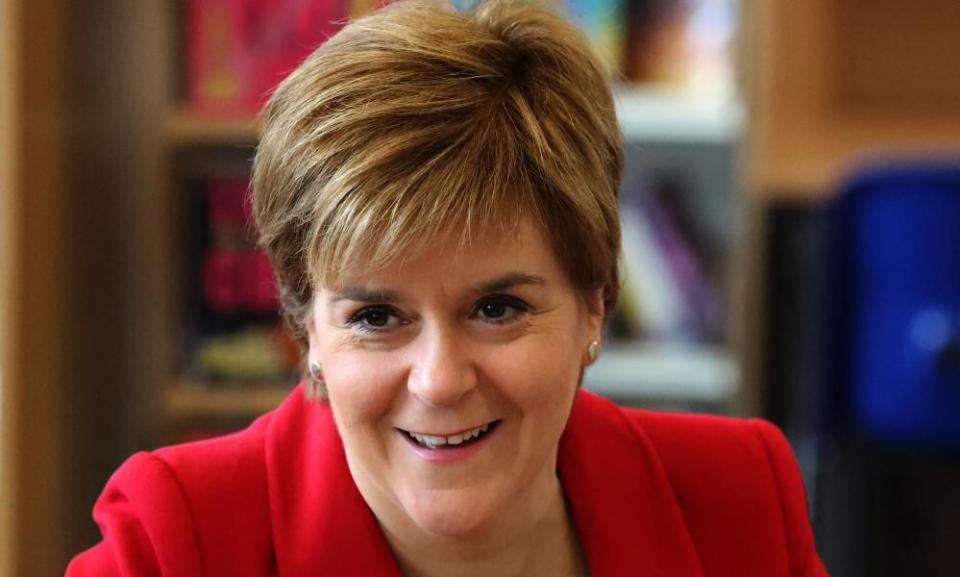Independent Scotland would need to cut deficit, says Sturgeon

Nicola Sturgeon has said an independent Scotland would face tough economic challenges after data showed the country spent £13.5bn more than it raised in taxes last year.
The first minister confirmed that if voters backed independence in the near future, Scotland would need a dramatic improvement in its finances to bring its current spending deficit of 8.3% down to 3%, the level most economists see as sustainable.
The Government Expenditure and Revenue Scotland (GERS) report for 2016-17 says the gap between spending and tax income in Scotland last year was three times the UK’s deficit of 2.4%.
Sturgeon said the figures also showed Scotland’s economy was becoming stronger, with the fiscal gap narrowing by £1.3bn year on year. Onshore tax revenues grew by 6.1% last year, the highest annual growth rate since records began in 1998-99.
She acknowledged that a more sustainable deficit level for Scotland would be under 3%, implying spending cuts or growth in tax revenue of about £7.5bn would be needed. She argued the GERS data was not directly applicable to the country’s performance after independence, and said the most immediate economic challenge facing Scotland was Brexit.
“I accept that Scotland’s economy has challenges and [I] always have done,” Sturgeon said. “Yes, Scotland has a deficit and it’s a deficit we want to see reduced to sustainable levels.
“This reflects Scotland’s position under current constitutional arrangements. Of course, if Scotland is independent, getting that deficit down to sustainable levels would be the responsibility of an independent Scottish government with the challenges which are inherent in that.”
The GERS report says overall public spending – combining UK and devolved spending – was £71.2bn, or 9.2% of the UK total. Including a geographic share of North Sea oil revenues, that was equal to 44.7% of Scotland’s estimated GDP – five points higher than the level of public spending across the UK as a whole.
The GERS data shows Scotland’s total tax revenues, including oil and gas taxes, stood at just under £58bn. That left Scotland with an estimated gap between income and spending of £1,437 per head – the widest gap since the last Scottish independence referendum campaign started in 2012.
The Scottish and UK governments spent £13,175 per head on public services in Scotland, including schools, hospitals, policing, welfare, transport and defence. The UK per capita rate was £11,739.
Opposition parties said the figures exposed how unreliable the claims made about Scotland’s wealth by Sturgeon and Alex Salmond, the then first minister, had been during the referendum campaign.
In November 2013 the independence white paper, Scotland’s Future, forecast oil revenues in 2016 would be between £6.8bn and £7.9bn. Salmond said that would help power the country’s growth.
In fact, GERS found the plunge in global oil prices and the UK government’s decision to cut North Sea taxes and increase decommissioning subsidies meant Scotland’s share of oil revenues was £208m – the second lowest figure since the 1970s.
The GERS report presents a notional figure for Scotland’s deficit, since its share of UK debt and relatively higher spending are funded at UK level and 37% of its public spending is controlled by the UK government, some of which is overseas.
The Scotland Office, the UK government department for Scotland, said the notional deficit meant public borrowing per person for Scotland was more than three times higher last year, at £2,453, than the UK figure of £704 per head.
David Mundell, the Scottish secretary, said: “Being part of a strong UK has protected our living standards, and that’s one reason the people of Scotland clearly rejected Nicola Sturgeon’s plan for a second independence referendum at the election.
“Scotland’s deficit is falling at a slower rate than the UK as a whole and economic growth is lagging behind. It is vital we grow the economy and we want to work with the Scottish government to achieve that.”
Many critics of independence warned during the 2014 referendum campaign that it was unwise for Scotland to rely on oil revenue to fund its higher-than-average public spending.
Sturgeon insisted on Wednesday, however, that no one had forecast the oil crash in 2015 that led to North Sea tax revenues plunging to near zero.
She said that since her devolved government did not have full control over taxation and UK economic policy, the UK government and supporters of the UK needed to explain why Scotland’s economy was comparatively weaker.
Sturgeon and Derek Mackay, the Scottish finance secretary, acknowledged the Scottish government had not commissioned any independent economic analysis which compared the effectiveness of their economic and public spending policies, which include removing all business rates for 100,000 small firms, with the UK government’s policies.
Prof Graeme Roy, director of the Fraser of Allander Institute at Strathclyde University, and formerly Salmond’s head of economic policy, said forecasts showed the gap in performance between Scotland and the UK as a whole would continue for the rest of this decade.
In a blog analysing the latest figures, Roy said GERS provided “a pretty accurate picture of where Scotland is in 2016-17” and was a useful starting point for analysing the challenges posed by independence. Those challenges would grow in future, he said.
“All countries face big fiscal challenges in terms of what will replace declining revenues in the face of rising spending pressures over the next few years,” Roy said. “Changing the constitutional set-up doesn’t alter the fact that these fiscal challenges need to be addressed by all governments in all countries. Today’s figures show that a more autonomous Scotland will be forced to meet such challenges sooner rather than later.”

 Yahoo News
Yahoo News 